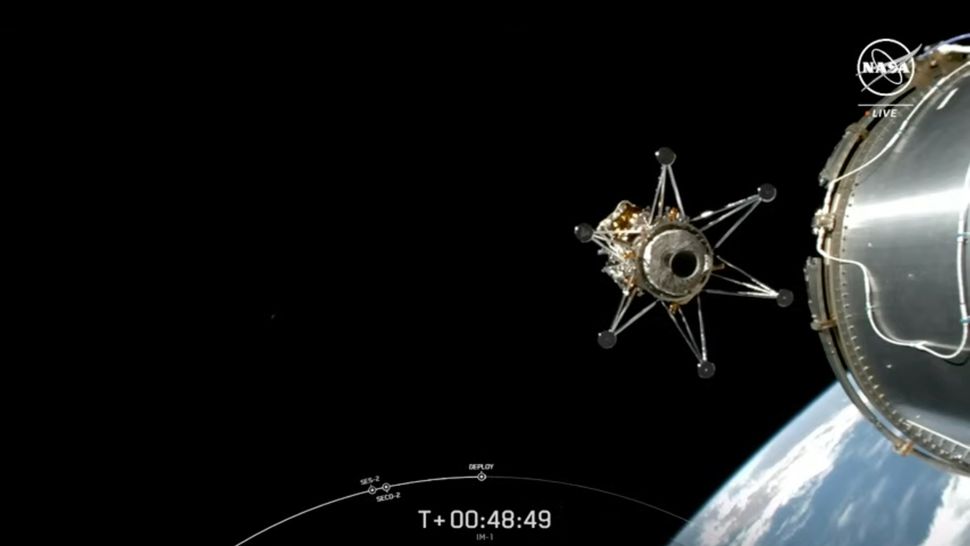We’re just hours away from what could be the first moon landing by an American spacecraft in 50 years, a success that would kickstart the nation’s hope to eventually establish a long-term presence on the moon as part of its Artemis program.
Odysseus (nicknamed “Odie”), a 14-foot-tall (4.3 meters) lander built and operated by Houston company Intuitive Machines, will attempt to land close to the moon’s south pole today at 5:30 p.m. EST (2230 GMT).
You can tune in to the landing live here at Space.com, courtesy of NASA, or directly via the space agency. Coverage will begin at 4:00 p.m. EST (2100 GMT).

Odysseus launched Feb. 15 on a six-day trip to the moon, ferrying 12 payloads, six of which are NASA science and technology instruments. (The agency paid Intuitive Machines $118 million for the ride to the moon.) After sailing more than 620,000 miles (1,000,000 kilometers), the telephone-booth-sized spacecraft aced maneuvers yesterday (Feb. 21) that put it in a tight circular orbit around the moon a day ahead of its landing.
“We’re very excited, but we’re also very nervous,” said Jack Burns, a professor at the University of Colorado, Boulder, who’s the principal investigator for one of the NASA science instruments onboard Odysseus. “The success has been mixed in going to the surface of the moon.”
If all goes to plan today, Odysseus will land on the rim of a small crater called Malapert A, about 190 miles (300 km) from the lunar the south pole on the Earth-facing side. Success would be historic, as no private probe has ever soft-landed on the moon before.
Others have tried. Pittsburgh-based Astrobotic’s Peregrine lander, which launched last month, was done in by a propellant leak and ended up crashing back to Earth. The Israeli Beresheet and Japanese Hakuto-R landers both reached lunar orbit but crashed during their touchdown tries, in April 2019 and April 2023, respectively.
Malapert A was the second site chosen for Odysseus’ mission, which is known as IM-1. The first was in Oceanus Procellarum, the largest lunar basaltic plain, which is also a potential landing site for the Artemis program, NASA’s endeavor to return astronauts to the moon for the first time since the Apollo era. Last year, however, Intuitive Machines changed the landing location to Malapert A due to worries over contaminating the region if Odysseus crashed.
“Landing near Malapert A also will help mission planners understand how to communicate and send data back to Earth from a location that is low on the lunar horizon,” NASA said in a statement at the time.
Malapert A is relatively flat and thus safe to land on, and Odysseus will target a landing area the size of an American football field, Burns said. During descent, the spacecraft will primarily rely on real-time images and onboard navigation software to adjust its speed and touch down gently near the crater.
“It’s a new place to land,” Burns told Space.com. “I think Intuitive Machines has done everything it can to prepare.”
IM-1’s surface mission is expected to last about half a lunar daytime, or roughly seven Earth days. (It takes the moon about 27 Earth days to rotate once around its axis.)
“Our lunar day is going to be a little bit shorter than it is at other places,” Burns said. “But we can do a lot of good science during that time.”
The short mission timeline also results from the fact that the sun will already be up at Malapert A by the time Odysseus arrives. Its landing region sizzles at over 212 degrees Fahrenheit (100 degrees Celsius) during the day, so radiators built into the spacecraft are expected to protect it from getting too hot.
However, the moon lander cannot survive a frigid night on the moon because there are no heaters on board to keep its electronics at operating temperature. Scientists expect observations to continue as long as the battery holds out, until a handful of hours after sunset.
Future missions will likely be equipped with heaters to help spacecraft survive the harsh lunar night, said Burns. For this one, though, “we just want to land, do some good, solid science during the lunar day and declare victory.”